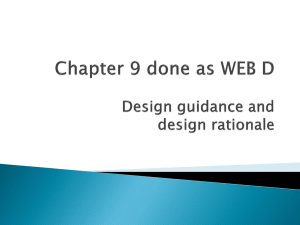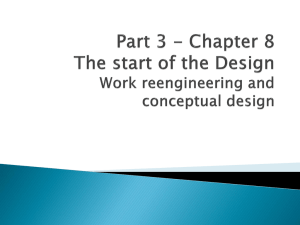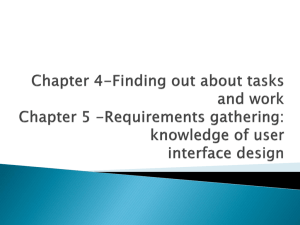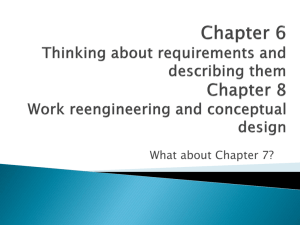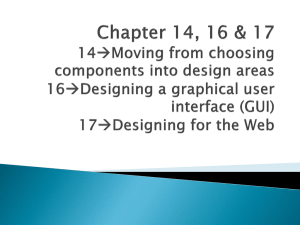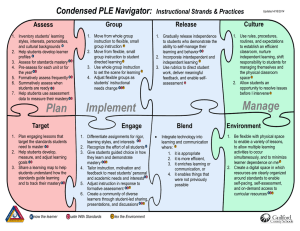lNTfRcHr93 24-29 April1993 A Second Generation User Interface
advertisement
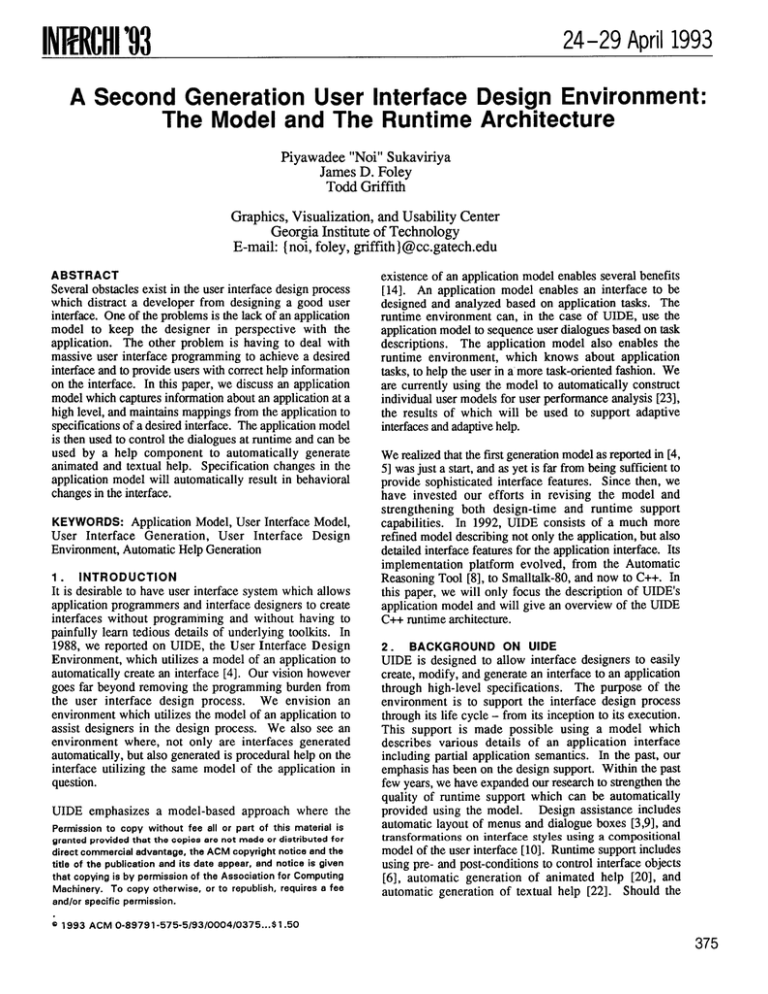
lNTfRcHr93
24-29 April1993
A Second Generation User Interface Design Environment:
The Model and The Runtime Architecture
Fiyawadee
“Noi”
James
Todd
Graphics,
Visualization,
and Usability
Center
Georgia
Institute
of Technology
E-mail:
{ noi, foley,
griffith]@cc.gatech.
edu
ABSTRACT
Several obstacles exist in the user interface design process
which distract a developer from designing a good user
interface. One of the problems is the lack of an application
model to keep the designer
in perspective
with the
application.
The other problem is having to deal with
massive user interface programming
to achieve a desired
interface and to provide users with correct help information
on the interface.
In this paper, we discuss an application
model which captures information about an application at a
high level, and maintains mappings from the application to
specifications of a desired interface. The application model
is then used to control the dialogues at rtmtime and can be
used by a help component
to automatically
generate
animated and textual help. Specification
changes in the
application model will automatically
result in behavioral
changes in the interface.
KEYWORDS:
Application
Model, User Interface Model,
User Interface
Generation,
User Interface
Design
Environment, Automatic Help Generation
1.
INTRODUCTION
to have user interface system which allows
application programmers and interface designers to create
interfaces without programming
and without having to
painfully
learn tedious details of underlying
toolkits.
In
1988, we reported on UIDE, the User Interface Design
Environment,
which utilizes a model of an application to
automatically
create an interface [4]. Our vision however
goes far beyond removing the programming
burden from
the user interface
design process.
We envision
an
environment which utilizes the model of an application to
assist designers in the design process.
We also see an
environment
where, not only are interfaces
generated
automatically,
but also generated is procedural help on the
interface utilizing
the same model of the application
in
question.
It is desirable
UIDE
emphasizes
a model-based
approach
where
Permission
to copy without
fee all or part of this material
granted provided
that the copies are not made or distributed
direct
commercial
titla
of the
that
copying
advantage,
publication
Machinery.
is by permission
To copy
and/or
specific
e 1993
ACM
the ACM
and its date
copyright
appaar,
notice
and notice
of the Association
otherwise,
Sukaviriya
D. Foley
Griffith
the
is
for
and the
is given
for Computing
or to republish,
requires
a fee
existence of an application model enables several benefits
[14],
An application
model enables an interface to be
designed and analyzed based on application
tasks. The
runtime environment
can, in the case of UIDE, use the
application model to sequence user dialogues based on task
descriptions.
The application
model also enables the
runtime
environment,
which knows about application
tasks, to help the user in a’ more task-oriented fashion. We
are currently using the model to automatically
construct
individual user models for user performance analysis [23],
the results of which will be used to support adaptive
interfaces and adaptive help.
We realized that the first generation model as reported in [4,
5] was just a start, and as yet is far from being sufficient to
provide sophisticated interface features.
Since then, we
have invested our efforts in revising
the model and
strengthening
both design-time
and runtime
support
In 1992, UIDE consists of a much more
capabilities.
refined model describing not only the application, but also
detailed interface features for the application interface. Its
implementation
platform
evolved, from the Automatic
Reasoning Tool [8], to Smalltalk-80,
and now to C++. In
this paper, we will only focus the description of UIDE’S
application model and will give an overview of the UIDE
C++ runtime architecture.
BACKGROUND
ON UIDE
2.
UIDE is designed to allow interface designers to easily
create, modify, and generate an interface to an application
through high-level
specifications.
The purpose of the
environment
is to support the interface design process
through its life cycle – from its inception to its execution.
This support is made possible
using a model which
describes
various details of an application
interface
including partial application
semantics.
In the past, our
emphasis has been on the design support. Within the past
few years, we have expanded our research to strengthen the
quality of runtime support which can be automatically
Design assistance includes
provided using the model.
automatic layout of menus and dialogue boxes [3,9], and
transformations
on interface styles using a compositional
model of the user interface [10]. Runtime support includes
using pre- and post-conditions
to control interface objects
[6], automatic
generation
of animated
help [20], and
automatic generation
of textual help [22].
Should the
permission.
0-89791
-575-5193
/000410375
. ..$1 .50
375
lNTfRcHr9
24-29 April1993
specifications in the knowledge base change, the generated
interface and help at run-time will change accordingly.
Through UIDE, a designer creates an interface for an
application by first describing objects and operations in the
application.
The designer then chooses various interface
functional
components which best fit the application
by
linking them to application operations. Interface functional
components
include interface actions, interface objects,
presentation objects representing application
objects, and
interaction
techniques to be used with presentation
and
interface objects. These components will be described in
more detail in Section 4.
Though the model has descriptions
of both application
tasks, and interface tasks and objects, we often refer to it as
“application
model.”
The terms “model” and “application
model” will be used interchangeably throughout this paper.
Once the application
model is mapped to interface
functional
components,
the UIDE runtime environment
uses the specifications
in the model to generate a desired
interface.
The specifications
are also used to control user
interactions
and status of interface objects at run time.
While the interface is running, context-sensitive
animated
help on “how” to perform actions can be constructed from
the specifications upon user request [20]. Help on “why” a
certain widget is disabled can also be generated using precondition
information
associated
with
actions
and
interaction techniques related to the disabled widget [6].
3.
RELATED
WORK
Direct
manipulation
user interface
builders
such as
DevGuide
[24] and Prototype
[2] make designing
an
interface one step easier. Some direct manipulation
tools
such as DialogEditor
[1] and Peridot [12] are intelligent and
they make the interface design process less tedious and less
repetitive.
These tools facilitate a bottom-up approach of
interface
design while UIDE emphasizes
a top-down
approach.
That is, designing a conceptual design of an
application before designing its interface. Also, these tools
mainly
assist with
layouts
and do not incorporate
application aspects in their assistance.
used by designers as ways to specify interaction styles for
an application.
UIDE’S application
model allows the
mapping of application actions to interfaces to be changed
without changing application
actions.
The model also
allows an application
action to be mapped to multiple
interface actions; this results in multiple access to a single
application command, for example.
Both HUMANOID
and UIDE have explicit descriptions of
application
objects.
They also have pre-conditions
for
actions which are used to determine when an action is
enabled and can be performed by the user. Only UIDE uses
post-conditions
of actions as a way to capture application
action semantics, and uses them to reason in the design
process and to provide help at runtime.
4.
APPLICATION
MODEL
We view the application model as consisting of three layers
which describe interface functionality
at different levels of
abstraction.
At the highest level, the model captures
semantics of application
actions. The mid-level captures
actions which exist in various interface paradigms but are
independent of any specific application.
The lowest level
describes mouse and keyboard interactions and is designed
to capture lexical groupings which define related lexical
input and output.
Through these layers, designers have
different granularity of control over interface features which
they can choose for an application.
Ideally, changing an
interface style is a matter of manipulating
connections
between these layers.
UIDE provides generic classes of various entities in the
application model. These classes will be introduced in the
next 5 subsections – Application
Objects, Application
Actions, Interface Actions, Interaction
Techniques,
and
Interface
Objects.
The application
model consists of
instances
of these classes;
each instance
contains
information specific to an application aspect it represents or
the particular interface features chosen for the application.
The power of the model comes from the specific contents
of these instances and also the semantic connections among
these instances.
Application
Cousin [7], MIKE
[16], MICKEY
[17], UofA*
UIMS
[19], and HUMANOID
[26] use descriptions of commands
and parameters to automatically
generate interfaces.
The
same approach is used in UIDE. It is used, however, with
a more sophisticated representation
structure.
Except for
HUMANOID
and UIDE, the systems above parse textual
descriptions of commands and parameters, either embedded
in a program structure or stored in a file, and use them as
inputs to interface generators in their systems. UIDE and
HUMANOID
store descriptions of application actions and
parameters as objects in their application model.
A
I_sE31
376
Objects
●
Figure
Figure
All these systems except UIDE do not explicitly
model
detailed descriptions of interface tasks beyond application
commands and parameters. We explicitly model interface
actions and interaction techniques, which are intended to be
Objects
1 shows
1 UIDE
a predefine
Object
000
Class Hierarchy
object
class-subclass
hierarchy
Application
objects are specific entities in an
application;
they are entities on which application actions
operate. Interface objects are entities which users perceive
and sometimes interact with, such as a window, an icon of
in UIDE.
INER(W93
24-29 April1993
a NAND gate, or an audio output, etc. We will discuss
more details on interface objects later in this section.
The application
designer defines object classes in an
application
by subclassing from the UIDE application
object class. Attributes of these classes are added by the
designer. Figure 2 shows an example of an extended class
hierarchy for a digital circuit design application.
In this
application,
end-users create different kinds of gates and
connect them to form a functional
digital circuit.
This
application will be used throughout this paper.
use first order predicate
logic (but do not yet handle
universal
and existential
qualifiers),
and their class
definitions capture such a representation.
An action which
requires parameters has pointers to its parameter instances.
Each parameter points to the constraint instances associated
with it, An action also points to pre- and post-condition
instances associated with it. Figure 3 depicts a graphical
view of an action with links to its parameters, its preconditions, and its post-conditions.
Each parameter is also
linked to its constraints.
I
General
Objects
Application
Interface
Objects
Objects
Pre-cond
Post-cond
Figure 3
I Gate
I-?7
Nor
● 00
I
A View of an Action and its Associated
Components.
I
Examples of application actions and their parameters in the
digitrd circuit design application are:
● 00
Figure 2 Object Class Hierarchy for a Digital
Layout Application
Circuit
The extended class hierarchy for application objects is often
referred to as the data model. We consider the data model to
be part of the application model. In an application such as
the circuit design progmm where objects are instantiated at
runtime by end-users, the designer only designs class
definitions
of objects.
Operations to create instances of
these objects should be provided
in the interface.
In
different applications
where there are a fixed number of
objects pre-created for end-users to interact with, the class
definitions of these objects must be defined and instances
created during the design process.
Application
Actions
To complete the application model, the designer
the functionality
of an application which will be
to the user as a set of actions.
UIDE provides
parameter, parameter constraint, pre-condition,
condition classes to capture application
actions
semantics.
describes
available
action,
and postand their
An action is a unit of activity which is meaningful
to an
application.
Executing
an action may affect objects,
attribute values of objects, or object classes, An action
may require parameters, hence the parameter class is defined
to describe a parameter of an action.
Constraints
on
parameter
types and parameter
values are defined as
instances of the parameter constraint class. More detailed
information about parameter constraint classes can be found
in [21]. The pre-condition
class is defined to capture what
needs to be true before an action can be executed and the
post-condition
class is defined to capture what will be true
after an action is executed. Both pre- and post-conditions
create-NAND-gate
create-NOR-gate
&lete-gate
move-gate
rotate-gate
connect
Figure 4 shows
related entities.
the “connect”
(location)
(location)
(gate)
(gate, new-location)
(gate, angle-of-rotation)
(gate-1, gate-2)
action
instance
with
its
I
exist (gate- 1)
connected (gatel, gate2)
Figure 4
The connect Action from a Digital
Design Application.
Circuit
Interface
Actions
Mapping from application components – actions and their
parameters – to an interface is specified as links from these
components to interface actions.
The designer does not
really define interface actions.
There are instances of
different interface actions already defined in UIDE from
which the designer can clone. Multiple
interface actions
can be linked to application components of one action. For
example, the “rotate” action may be linked to a “selectaction” interface action. Its parameters, object and angle-ofrotation, may be linked to “select-object” and “enter-integerin-dialogue-box”
interface actions respectively.
On the
377
lNliiRcHr93
24-29 April1993
current C++ platform, linking is done through C++ code.
We do not yet have a friendly
interface to the model
acquisition process.
Interface actions may have pre- and post-conditions.
Some
pre-conditions
are concerned with the status of an interface
prior to performing
interface actions,
For example, the
dialogue box, which contains the numeric input widget for
entering an angle of rotation,
must be visible before a
number can be entered. Some pre- and post-conditions
are
For
concerned
with sequencing
of interface
actions.
instance, an angle of rotation cannot be entered unless an
object has been selected, and an object cannot be selected
unless the rotate action has been selected. Sequencing preand post-conditions
can be automatically
derived by UIDE
from the application semantics [10].
beforehand
so their references
can be used in the
specifications in the application model.
Figure 5 depicts the overall layers in the application model
for each action and figure 6 shows a graphical view of the
semantic links of the “rotate” action.
We omit pre- and
post-condition
details, and parameter information
to keep
the figures clear. The application semantics level serves as
a starting point in the design process and is independent of
the end-user interface.
The application model consists of
several application actions described in this structure. The
same application
can be mapped to multiple
sets of
interface actions and techniques for different environments.
1
----Interaction
Techniques
Interaction
techniques specify how interface actions are to
be carried out by the user. Interaction technique instances
are linked to interface actions. For example, if the “selectobject” action is to be performed by using the mouse to
click on an object, a “mouse-click-object”
technique must
More than one interaction
be linked
to the action.
technique can be linked to an interface action to designate
possible alternative interactions.
For instance, an object
can also be selected by typing in the object name. In this
case, a “type-string”
technique is attached to the “selectobject” action.
-1
------
----- F
------
t
-.
_!-?_?-?_L-?.
c?!5de3@
Figure 6 A Rotate
Interface
UIDE’S
interaction
techniques
are similar
in function to
Myers’ interactors
[13].
We, however, do not model
feedback as objects in UIDE. We treat feedback as different
behaviors of presentation objects. Also, we do not treat an
object as a parameter of an interaction technique. Rather,
as will be described later, interaction techniques are attached
to objects.
Objects
-~
●
Action Instance
Presentation
00
Objects
Bitmapped
z
‘
System Interface
Objects
OLIT
Objects
Motif
Figure 7 Interface Object Subclasses
Figure 7 illustrates the UIDE class-subclass hierarchy down
from the interface object class. The 2 major subclasses of
objects, which represent
interface objects are: presentation
application
objects and are presented to the user through
various forms or media; and system interface objects, which
are standard
or Motif
Figure 5 Specifications
Layers in the Application
Model
Interaction
techniques
may also have pre- and postconditions.
Their pre- and post-conditions tie closely to the
screen context, for example, the numeric input widget must
be enabled for a type-in-number
technique, and will be
disabled after a number is entered. Interface objects such as
dialogue boxes, menus, buttons, etc., must be created
378
widget
[18].
objects
in interface
Currently
toolkits
we are only
such as OLIT
working
[25]
on the OLIT
set.
The system interface
object allows common interface
objects to be referred
to as buttons,
scrollbars,
etc.,
regardless of the underlying toolkits. Many of our interface
object classes are similar to interactor classes in InterViews
[11] and we maintain a part-whole structure for composite
objects such as dialogue
boxes in a similar
fashion.
lNTfRcHr93
24-29 April1993
However, unlike InterViews, we allow interactive behaviors
to be programmed
on interface
objects by attaching
interaction
techniques
to interface
object classes or
instances, This is used more in the case of presentation
objects where different
behaviors
may be desired for
different forms of presentation. We have not yet supported
adding behaviors to standard widgets, though this can be
between application
data and its interface
modeled.
With application
routines in place, UIDE
support the rnntime execution of an application
done using
The designer
Controlling
the Interface
Through
the Model
components in the application model are instances of
a C++ class.
In addition
to members
and member
functions which are used to maintain specific information
contents and semantic relationships
in the model, these
instances are designed to support runtime execution of the
interface.
Some examples are: 1) each system interface
object has the actual calls to corresponding
OLIT widgets
to create or modify themselves; 2) parameter instances
maintain
current parameter
values; and 3) parameter
constraints are used to validate pammeter values, etc. The
presentation
UIDE
runtime
action
semantics
our current
underlying
mechanisms.
5.
RUNTIME
need to be
is ready to
interface.
ARCHITECTURE
Most
To make
this
point
clear,
let’s
wishes
to make
all gates
double
clicking
on a NAND
change
the
achieve
such a design,
time
of the Bitmapped
“mouse-drag”
this
linked
a NAND
in nanoseconds
class called
technique
the
allow
of
first
subclass
technique
that
gate.
to a “change-NAND-time-delay”
To
a subclass
then attaches
to the class.
action.
of the GATE
technique
would
only
the user to
creates
GATE,
designer
but
Notice
is the same instance
application
a “double-clicking”
“double-clicking”
that
by dragging,
gate would
the designer
technique
to the “move-gate”
class and attaches
linked
object
interaction
“mouse-drag”
then creates
This
delay
assume
movable
a
that
which
is
to the class.
be one which
is
action.
This
means
sequence
runtime
Creating
the Model
The designer furnishes an application model for UIDE by
first defining application actions, application and interface
objects, then choosing interface actions and interaction
techniques as she sees appropriate. This process creates the
declarative model which serves as specifications for UIDE
to sequence dialogues for the application.
Currently,
defining
the model in the C++ version of UIDE is still
done through the standard C++ declaration and instantiation
syntax. A visual tool to create an application
model has
been planned.
architecture
that
UIDE
does
and bindings
code.
When
model
changes,
change
according
model,
UIDE
the current
updates
—
is designed
are used to guide
not
sequences
the dialogues,
In addition to the model, the designer also provides, for
each application action, an application routine which will
be invoked at runtime when all parameter values for the
action have been entered or selected. Application routines
are responsible for handling necessary computations and
manipulations in an application.
Occasionally, application
routines may need to address contextual changes in the
interface. Currently, once an application object is created
and registered, its corresponding presentation object will be
displayed.
This works well for the circuit
design
application we are using. More sophisticated dependencies
and
n
8
components
manager
in the
maintains
when appropriate.
Figure 8 UIDE’S
Figure
the
in the
behaviors
which
1
1
There are constraints
on which interface
actions and
techniques are appropriate
for which types of interface
objects.
There are also constraints on which interface
actions are appropriate
for which parameter types with
which they are associated. These constraints vary from
rigid rules, such as a radio button bank cannot be used for
entering a floating point numeric value, to style guide-like
rules such as a long list of choices should be presented in a
scrolling list. Declaring the model using the C++ syntax
does not prevent the designer from using interface actions
and interaction techniques inappropnatel y. It is importaut
to incorporate this kind of constraints to assist designers in
a tool for creating the model.
in
and behaviors
to instance
manager”
context,
dialogue
specification
sequencing
has a “dialogue
sequencing.
the
techniques
the application
y. In addition
interface
hard-wire
to interaction
the interface
the context
such that application
the dialogue
shows
information
in UIDE’S
updates
user finishes
Runtime
runtime
the screen
an interface
flow
among
architecture.
context
action
u
Architecture
appropriate
– an interface
various
The dialogue
y after
action
the
could
be the user has just selected an action or an object. The
dialogue manager maintains the user interface context to
keep track of which action the user is performing.
Each
application
action has a pointer
to its corresponding
application routine. Once all parameter values of an action
have been entered by the user, it invokes the application
routine for that action, The application routine may update
data in the data model which resides in the application
model. For an application which resides on the same C++
platform such as the circuit application
we use, the data
model can be directly used as the data structure of the
application.
A general theme for controlling
the inteflace is as follows.
First, the dialogue manager checks to see whether each
application action has all its pre-conditions
satisfied.
A
combination
of 1) traditional
unification
and resolution
mechanisms for the predicate language [15], and 2) treating
pre-condition
as functions
for checking
conditions
on
379
lNTfRcH1’9
24-29 April1993
Figure
Figure
380
10 Interfaee
9 Interface
to the Circuit
to the Circuit
Design
Design
Application
Application
with
some Gates in the Design.
lNTfRrJHr93
objects, are used for handling pre- and post-conditions.
An
action with all its pre-conditions satisfied is enabled, and an
action with at least one pre-condition
unsatisfied
is
disabled. This situation is reflected in the interface through
links in the model,
That is, the interface actions and
interaction techniques associated with enabled actions are
enabled.
Interface
objects associated with enabled
interaction techniques are also enabled and their statuses are
changed (i .e, from invisible to visible).
Interface objects
associated with disabled interaction techniques are disabled
and their statuses are also changed (i.e, from solid to
greyed-out)
Figure 9 and 10 illustrate examples of these
conditions.
Notice from the interface to the circuit design application in
figure 9 that the gate icons on the left are for invoking
application actions which instantiate the corresponding gate
types. When one of these icons is selected, UIDE waits for
a location
input in the current design space. Once a
location is given by the user, a gate is instantiated and its
graphical view is placed at the given location. In figure 9,
since there are no gates in the system, all actions in the
“Gates” menu are disabled because all of them require that
some gates exist in the design. This interface assumes a
prefix interface paradigm – an action is selected first before
objects and/or parameter values for the action are selected.
Figure 10 shows the menu changed as some gates have
been created.
This design can be changed so that an object must be
selected before some actions on gates, “delete” and “rotate”
for example, are enabled. This is done by making “selectobject” interface action an action by itself (as opposed to
linking to an application
action), which results in a postcondition that an object exists as the current selected object
(CSO as referred to in [4]). The resulting interface would
be one that, though gates exist, “delete” and “rotate” menu
items are not enabled unless one of the gates is selected.
Generation
of How and Why Help
Automatic
Two kinds of help can be automatically y generated from the
application model: how to perform an action and why an
interface object is disabled.
We use 2 types of help
presentation modes, textual and animated help,
It should be obvious
now that procedural
steps for
completing an application action can be inferred from the
application model, For example, rotating an object can be
done by first selecting the rotate action, selecting an object
to be rotated, and then entering the degree of rotation. To
animate this action, UIDE chooses an object of type GATE
from the current context using the constraint
for the
“object” parameter which state that the object must be of
type GATE.
An integer number between O to 360 is
chosen for the “angle of rotation” parameter according to its
cons traints.
UIDE then illustrates
the procedure by
showing a mouse icon on the screen, the left mouse button
being pressed while pulling
down the menu where the
“rotate” item is located, releasing the mouse button at the
“rotate” item, clicking on the chosen object, and typing the
24-29 April1993
number chosen for the “angle-of-rotation”
in the dialogue
box designed for this action.
Pre- and post-conditions
are used to evaluate whether a
context is ready for animating an action. For example, to
rotate a gate, a gate must exist. If there is no gate in the
current context, a planner is invoked to search for an action
in the application
model which will create a gate. The
animation will show creating a gate first, and then rotating
the gate.
A interface object is disabled if the interaction technique
associated with it is disabled. An explanation
of why an
interface object is disabled can be generated using preconditions
[22].
The explanation
also includes which
actions must be performed the make the object enabled.
6.
IMPLEMENTATION
The 1992 UIDE is written
in C++ using the OLIT widget
set. It runs on Sun’s X Server.
Though we use OLIT,
UIDE does not generate conventional
code with callbacks
for application programmers to add their application code.
All application routines must be written separately and are
connected to UIDE through application actions.
A subset of the OLIT widget set has been incorporated
in
UIDE’S interface object structure. Our major efforts have
been placed on connections from the application model to
the actual execution of the interface.
The animated help
was developed earlier in Smalltalk-80
and is now being
ported to C++. Generation of WHY explanations has been
developed separately in C++ but has not yet been integrated
into UIDE.
7.
CONCLUSIONS
The application model in UIDE consists of entities which
describe an application through actions, action semantics,
objects, and interface details of its interface.
We have
explained the structure of a model which captures the
semantic relationships
among these entities.
We also
described the runtime architecture which 1) controls the
dialogue sequencing, and 2) automaticdl y generates how
and why help using the model.
Taking away the burden of having to program an interface
is already a major relief to most of us who need to create an
interface and who have no interest in unnecessary details
which distract us from the design process.
However, a
greater contribution
of UIDE lies in the fact that it allows
application designers to focus on modeling the application
even before being hassled by interface design issues. The
designer can later link the high-level
model of the
application to interface details, and can therefore focus on
tasks and communication
means provided to users through
the interface.
This contribution
is one of many benefits
embled by the model-based user interface design approach.
ACKNOWLEDGEMENTS
This work has been supported by the Siemens Corporate
R&D System Ergonomics
and Interaction
group of
Siemens Central Research Laboratory,
Munich, Germany,
31
24-29 April1993
and the Human Interface
Technology
Group of Sun
Microsystems
through
their Collaborative
Research
Program.
The work builds on earlier UIDE research
supported by the National Science Foundation grants IRI88-131-79
and DMC-84-205-29,
and by the Software
We thank the members of the
Productivity
Consortium.
Graphics, Visualization,
and Usability
Center for their
contributions
to various aspects of the UIDE project: J.J.
“Hans” de Graaff, Martin
Frank, Mark Gray, Srdjan
Kovacevic,
Ray Johnson, and Krishna Bharat. We also
thank colleagues
and former
students at the George
Washington University who contributed to UIDE: Hikmet
Senay, Christina Gibbs, Won Chnl Kim, Lucy Moran, and
Kevin Murray.
We also thank Thomas Kuehme, John
Stasko, John Shilling,
and the reviewers
for their
comments.
REFERENCES
Cardelli, L. Building User Interfaces by Direct
Manipulation.
In Proceedings of the ACM
SIGGRAPH Symposium on User Interfme Software
and Technology. Banff, Alberta, Canada. October,
1988, 152-166.
SmetherBames, Portland,
2. Cossey, G. Prototype.
Oregon, 1989.
3. de Baar, D.; J.D. Foley; and K.E. Mullet. Coupling
Application Design and User Interface Design. In
Proceedings of Human Factors in Computing
Systems, CHI’92. May 1992,259-266.
4. Foley, J.D.; C. Gibbs; W.C. Kim; and S. Kovacevic.
A Knowledge-based User Interface Management
System. In Proceedings of Human Factors in
Computing Systems, CHI’88. May 1988,67-72.
5. Foley, J.D.; W.C. Kim; S. Kovacevic; and K. Murray.
UIDE-An
Intelligent User Interface Design
Environment. In Architectures for Intelligent
Inter f~es: Elements and Prototypes. Ekls. J. SuIlivan
and S. Tyler, Reading, MA: Addison-Wesley,
1991.
6. Gieskens, D. and J.D. Foley. Controlling User
Interface Objects Through Pre- and Post-conditions.
In
Proceedings of Human Factors in Computing
Systems, CH1’92. May 1992, 189-194.
7. Hayes, P.J.; P. A. Szekeley; and R.A. Lerner. Design
Alternatives for User Interface Management Systems
Based on Experience with COUSIN. In Proceedings of
Human Factors in Computing Systems, CHI’85. April
1985, 169-175.
8. Inference Corporation. ART Reference Manual.
Inference Corporation, Los Angeles, CA, 1987.
9. Kim, W. C., and J,D, Foley. DON: User Interface
Presentation Design Assistant. In Proceedings of the
ACM SIG GRAPH Symposwm on User Interface
Software and Technology. October 1990,.10-20.
10. Kovacevic, S. A Compositional
Model of HumanComputer Dialogues. In Multimedia Inlerfme Design.
E&. M.M. Blattner and R.B. Dannenberg, New York,
New York: ACM Press, 1992.
11. Linton, M.; J.M. Vlissides; and P.R. Calder.
Composing User Interfaces with InterViews.
IEEE
ComDu~er 22(2): 8-22. Februarv. 1990,
1.
382
INTERCH
12 Myers, B. Creating Interaction Techniques by
Demonstrations.
IEEE Transactions on Computer
Graphics and Applications
7 (September 1987):51-60.
13 Myers, B.; D.A. Giuse; R.B. Dannenberg; B.V.
Zanden; D.S. Kosbie; E. Pervin; A. Mickish; and P.
Marchal. Garnet: Comprehensive Support for
Graphical, Highly-Interactive
User Interfaces. IEEE
Computer 23(1 1): 71-85, November, 1990.
14 Neches, R.; J.D. Foley; P. Szekeley; P. Sukaviriy~
P. Luo; S. Kovacevic; and S. Hudson. Knowledgeable
Development Environments Using Shared Design
Models. To appear in Proceedings of Intelligent
Interfaces Workshop, Orlando, Flori&, January 4-7,
1993.
15< Nilsson, N.J. Principles of Artificial
Intelligence.
Los Angeles, CA: Morgan Kaufmann publishers, Inc,
1980.
16, Olsen, D. MIKE: The Menu Interaction Kontrol
Environment.
ACM Transactions on Graphics 5,4
(1986): 318-344.
17. Olsen, D. A programming Language Basis for User
Interface Management. In Proceedings of Human
Factors in Computing Systems, CHI’89. May 1989,
171-176.
18. Open Software Foundation.
OSF/Motif
Style Guide.
Revision 1.0. Englewood Cliffs, New Jersey: Prentice
Hall, Inc., 1990.
19, Singh, G. and Green, M. A High-Level User Interface
Management System. In Proceedings of Human
Factors in Computing Systems, CHP89. May 1989,
133-138.
20. Sukaviriya, P., and J.D. Foley. Coupling a UI
.
Framework with Automatic Generation of ContextSensitive Animated Help. In Proceedings of the ACM
SIGGRAPH Symposium on User Interf~e
Software
and Technology. October 1990,.152-166.
21. Sukavitiya, P. Automatic Generation of Contextsensitive Animated Help. A Ds. C. Dissertation,
George Washington University,
1991.
22, Sukaviriya, P. and de Graaff, J. Automatic Generation
of Context-sensitive
“Show & Tell” Help. Technical
Report GIT-GVU-92-18.
Atlanta, Georgia Graphics,
Visualization, and Usability Center, Georgia Institute
of Technology, 1992.
23. Sukaviriya, P. and J.D. Foley. Supporting Adaptive
Interfaces in a Knowledge-Based User Interface
Environments.
To appear in Proceedings of Intelligent
lnterf~es
Workshop, Orlando, Florida, January 4-7,
1993.
24. SunSoft. Open Windows TMDevelopersGuide 3.0
User’s Guide. Sun Microsystems, Inc. Part No:80C6585-10, Revision A, November 1991.
Sun
25. SunSoft. OLIT 3.0.1 Reference Manual.
Microsystems, Inc. Part-No: 800-6391-10, Revision
A, jnne 1992.
the
26. Szekeley, P.; P. Luo; and R. Neches. Facilitating
Exploration of Interface Design Alternatives: the
HUMANOID
Model of Interface Design. In
Proceedings of Human Factors in Computing
Systems, CHI’92. May 1992, 507-515.
